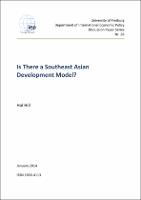Browsing by Subject "Southeast Asia"
Now showing items 1-5 of 5
-
Is There a Southeast Asian Development Model?
(Department of International Economic Policy Institute for Economic Research University of Freiburg, 2014)
The 10 states of Southeast Asia have combined to form the developing world’s most successful and durable regional grouping, the Association of Southeast Asian Na-tions, ASEAN. Economic integration among them is high and increasing. The ambi-tious ASEAN Economic Community is scheduled to take effect from December 2015, and should further accelerate this integration. But the socio-economic and institution-al disparities among them are also very large. This paper therefore asks the ques-tion, does it make sense to contemplate a ‘Southeast Asian ... -
A systematic review of factors influencing participation in two types of malaria prevention intervention in Southeast Asia
(2021-04-20)
Background: Multi-pronged malaria elimination strategies are increasingly being considered for accelerating efforts against malaria transmission in Southeast Asia. Two malaria prevention interventions used in in the region are insecticide-treated bed-nets (ITNs) and mass drug administration (MDA). Universal access to ITNs is recommended and high population coverage (e.g. above 80%) is needed during MDA initiatives to maximize the impact of these interventions. However, variability in ITN use and individual MDA participation exists. This systematic ... -
Universal health coverage in 'One ASEAN': are migrants included?
(2015-01-24)
Background: As the Association of South East Asian Nations (ASEAN) gears toward full regional integration by 2015, the cross-border mobility of workers and citizens at large is expected to further intensify in the coming years. While ASEAN member countries have already signed the Declaration on the Protection and Promotion of the Rights of Migrant Workers, the health rights of migrants still need to be addressed, especially with ongoing universal health coverage (UHC) reforms in most ASEAN countries. This paper seeks to examine the inclusion ...





